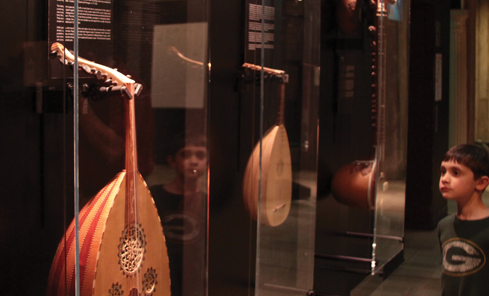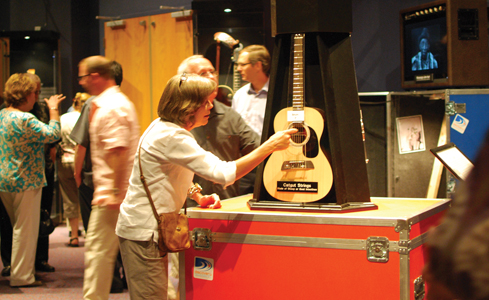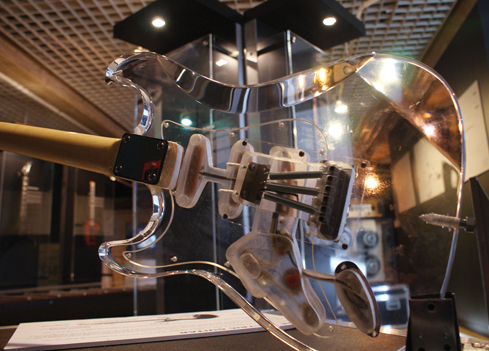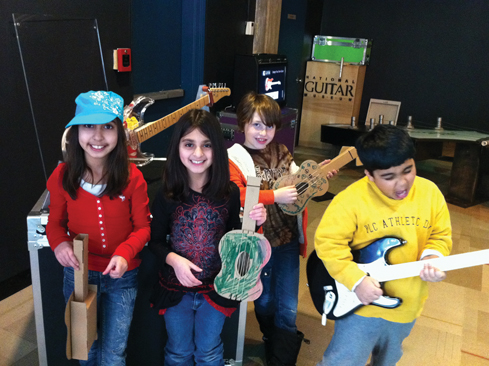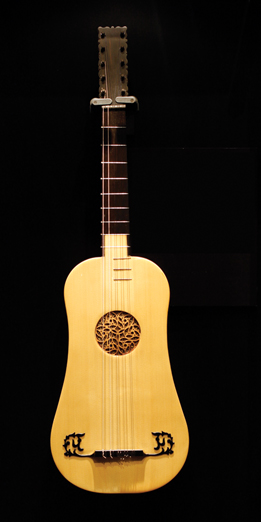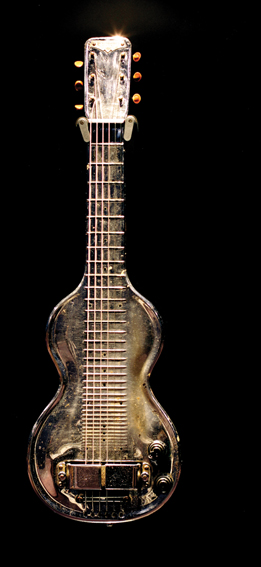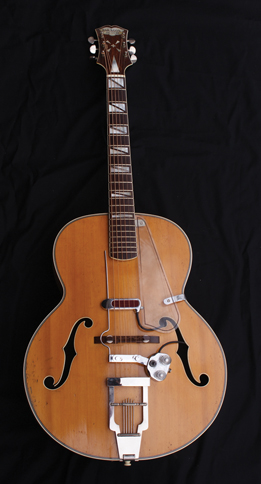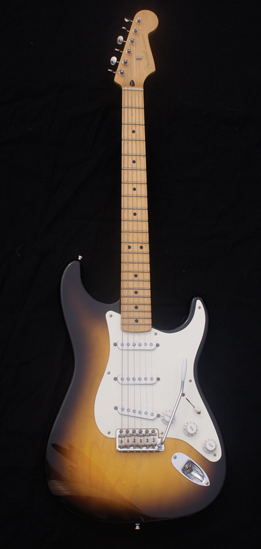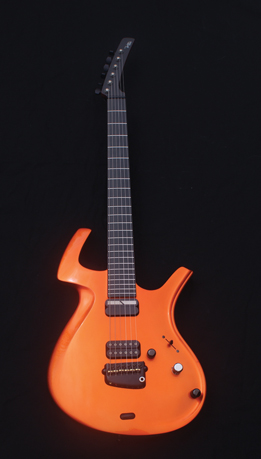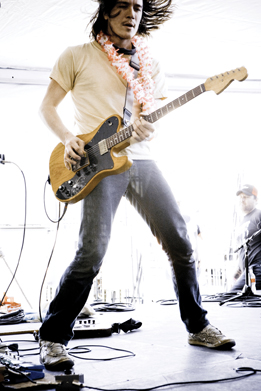 |
|||||||||||||||||||||||||||||||||||||||||||||||||
|
|
On tour at Carnegie Science Center, the world's most popular instrument gets its solo.
"I think I gotta get outta here, 'cause my Linda, she don't live here no more," Jimi Hendrix crooned at the 1970 Isle of Wight Festival. "That's alright—I still got my guitar."
From a bluesy simmer, the Gibson Flying V in his hands boiled over with sex and heartbreak, inhuman shrieks, and pure electricity. The Flying V, introduced in the late 1950s, is pure Space Age, with an aerodynamic body that seems to fly into the future. When Hendrix played it, clad in flame-colored psychedelic robes, he aimed that rocket ship—past Russia, past even the Moon—toward the valleys of Neptune. The Flying V that will greet visitors to a new traveling exhibit at Carnegie Science Center is essentially the same as Hendrix's: a V-shaped body in black and white, six strings, magnetic pickups. This one, however, lies flat on its back—and is 43.5 feet long.
The world's largest playable guitar—created by a high school class in Texas—is just the start of GUITAR: The Instrument That Rocked the World, developed by the National Guitar Museum and opening at the Science Center on June 16. Through interactive displays, listening stations, and nearly 60 different guitars, the exhibit explores the science of sound, the instrument's cultural impact, and its evolution from 16th-century ancestors to today's high-tech models.
Stratocaster ScienceWhen Mark Lewney teaches the physics of sound and acoustics, his primary teaching tool is an electric guitar —an Ibanez painted with cosmic designs and a portrait of Einstein. "Strings sound nice because these regularly-spaced harmonics are all happening at once," says Lewney in "Einstein Meets Hendrix," a three-minute video in the GUITAR exhibit. "Now, on an electric guitar, magnets convert the harmonics into sine-wave signals"—and from there, he demonstrates, to the distinctive sound of '80s lead guitar. "So that rock guitar sound isn't a kind of magic," he says, with a flurry of notes. "It's just simple physics." Lewney, who hails from Liverpool and studied physics at Edinburgh University, holds a Ph.D. from Cardiff University in—you guessed it—guitar acoustics, and serves as a science and technology advisor for the exhibit. The guitar makes a useful science demonstration tool. Its moving parts are simple and located on the outside. The strings can be used to demonstrate properties of sound waves, and electric guitars and amplifiers can launch discussions of electromagnets and electrical circuitry. "I think kids can see the connections [between science and music]. The portability of the guitar turns it into a one-on-one experience."
- Tom Sullivan, associate teaching professor of electrical and computer engineering, Carnegie Mellon University
The guitar is also familiar, and its fret board makes musical relationships easy to visualize. "I think kids can see the connections" between science and music, says Tom Sullivan, an associate teaching professor of electrical and computer engineering at Carnegie Mellon University. "The portability of the guitar turns it into a one-on-one experience." Sullivan, who teaches electro-acoustics and signal processing, became interested in radio and electronics as a child. He was in high school when he bought his first guitar, a Fender Stratocaster—"the perfect vehicle for dabbling in electronics," he says, and music. Now with children of his own, Sullivan uses the guitar as a teaching tool. Speaking at his son's elementary-school science fair, he brought along his guitar, an oscilloscope, a function generator, and a laptop with recording software. After helping the kids record several different instruments, "we looked at the waveforms on the computer," comparing them to standard wave shapes. And that Strat Sullivan bought in high school? "Thirty-some years later, I still have it," he says. "Strings sound nice because these regularly-spaced harmonics are all happening at once. On an electric guitar, magnets convert the harmonics into sine-wave signals. So that rock guitar sound isn't a kind of magic. It's just simple physics."
- Mark Lewney, Technology advisor for Guitar
While some elements are standard, like the fret board, or fingerboard, the rest of the guitar is fair game for wild experimentation, whether in the pursuit of sonic excellence, fashion, or a quick buck. Starting with ancestors such as the lute, the exhibit traces the guitar's evolution up through today's exotic shapes and materials, ersatz guitar-shaped synthesizers, even a Guitar Hero® video-game controller. In between are 16th-and 17th-century European precursors to contemporary classical and steel-string acoustic guitars. But the crucial design element of the guitar, some say, is invisible. "It's called 'tone,'" says Dick Boak, with a chuckle. "We joke that we start with tone, then we build a guitar around it." Boak has worked for the Martin guitar company in various capacities since 1976; he currently directs the company's museum and archives in Nazareth, Pa., and special projects. On August 25 and 26, Boak and guitarist Craig Thatcher will visit the Science Center with a collection of rare Martins, presenting the instruments in a historical and musical context. When Boak talks about the parlor guitar, for example, Thatcher will play an appropriate period piece on that instrument. "As we get into the 1920s, maybe a Scott Joplin piece," he notes. Martins are highly sought-after; although they look conservative, they represent designs tweaked over decades in pursuit of that elusive tone. "It's a very simple concept," says Boak, "but it's evolved here for 180 years." The emergence of the electric guitar, however, threw out the rulebook. "The electric guitar isn't constrained by anything, tonally," says Boak. "It can be made in the shape of the state of Texas; it can be made in a Flying V." Today, the Flying V looks rather staid compared to instruments with radical shapes and exotic materials like clear acrylic, aluminum, and carbon fiber. Some of the odd electrics in the GUITAR exhibit are sleek, like the teardrop-shaped Vox Phantom, while others look straight out of Dungeons & Dragons. Tools and the tradeIn addition to science and technology, GUITAR aims to convey the instrument's history and cultural significance. But like any pop-culture icon, the guitar has its uncomfortable paradoxes. According to the National Guitar Museum, 3 million new guitars are sold in the United States each year—more than all other instruments combined. The Musician's Friend website offers 1,891 different electric guitars, 578 acoustics, 822 acoustic-electric guitars, 214 classical and nylon-string instruments, and 39 "guitar value packages." Most of these instruments are priced between $100 and $750. (Musicians' Friend is a subsidiary of big-box retailer Guitar Center, one of the exhibit's partners.) "I didn't learn to play guitar, I felt it out."
- Phil Boyd of the Pittsburgh rock band Modey LemonWe often associate the guitar—especially the electric variety—with youth and individuality, free expression and rebellion, yet it embodies aspects of mass production and consumer culture like no other. In a sense, the electric guitar is the "have it your way" instrument. Yet these often factory-made, bolted-together instruments can inspire unorthodox techniques and wildly creative music. While some prominently display their prized guitars, Phil Boyd's nine guitars are workhorses, stabled in odd corners of his Squirrel Hill home. Many of them he bought used, and he frequently points out how inexpensive they are. "You could probably buy one for $25," Boyd says, holding a battered Hohner acoustic, a Christmas present from 1995. "It feels like cardboard!" The guitar bears the marks of a musician coming of age: a Beck sticker, a crudely fitted pickup, and the enigmatic phrase "elephant thunder" scrawled upside-down near the sound hole. Boyd began playing guitar at 14, inspired by Jimi Hendrix, but focused on his own style and writing his own songs. "I didn't learn to play guitar," he says, "I felt it out." As singer and guitarist for Pittsburgh underground rock band Modey Lemon, Boyd mastered a hard-edged style influenced by punk and blues, and that combined guitarist and bass-player roles. While the band would later add a bassist, Modey Lemon began as a duo, and Boyd had to find ways to fill out the low end of the sound, starting with the heavy-gauge strings Boyd now prefers. "I knew things weren't quite right with my setup early on," Boyd says. But through experimenting with different combinations of ready-made gear, he found an elegant solution of switches and amps that felt natural. He's not interested in gear-for-gear's-sake. "The more abstract elements of it," he shakes his head, "I sometimes forget what parts of my pedals do." His guitars also trace his path from teen fan to touring musician. After learning on a Stratocaster, he adopted the sturdy, inexpensive Telecaster for Modey Lemon's first tours—and with good reason.
Drawing upon lessons learned on the road, Boyd gradually merged his favorite guitar features, culminating in a custom instrument handmade by a friend. Even its plain, natural wood finish speaks to Boyd's aesthetic preferences. His newer solo work, Phil Boyd and the Hidden Twin, often combines electronics with Boyd's voice and acoustic guitar. Lately, he favors a $75 dull brown nylon-string acoustic. For all the science involved, for all its technological developments and pop-culture impact, much of the guitar's magic comes from the way even the cheapest factory-made instruments can become a tool for personal expression and idiosyncratic music. "I can't hurt it," Boyd says, laughing. "It makes me fearless." Local LuthierySeveral instruments coming soon to Carnegie Science Center—the Martin acoustics—speak to Pennsylvania's role in guitar history. In 1839, C.F. Martin & Co. moved from New York City to Nazareth, Pa., where the family company has made instruments ever since. Today, about 550 people work for Martin in the tiny Lehigh Valley town, says Dick Boak, director of the company's museum and archives. While the strings and entry-level instruments are made in Mexico, "the bread and butter of the Martin line [15 Series and above] is what's made here in Nazareth." Pennsylvania also has plenty of small, independent luthiers, says Boak. In Pittsburgh, these guitar-makers cover a wide range of creative goals. Under the name OZMA Instruments, local artist and designer Jeff Schreckengost creates electric guitars with highly stylized bodies, often sculpting salvaged hardwoods into retro-futurist swoops and angles. Striking finishes and vintage hardware complete the eye-catching instruments. Not that he stops there. For one unbelievable guitar, Schreckengost covered the body and neck with a vintage polyester bird-print shirt, sealed under epoxy. "Not everything went as planned," Shreckengost writes on his blog. "Any space that had a seam or wrinkle in it was covered with bird photos from a used nature guidebook and covered in another layer of resin. This guitar turned out much weirder and wilder than I expected." Another luthier with Pittsburgh roots, Josh Beyer, has taken a different approach. "Most of the instruments I build don't have much decoration," he says. "I really like the structure, the physics of the guitar." His first experiments in instrument making, such as a gigantic banjo, were driven by curiosity and intuition, but Beyer soon enrolled in an introductory luthier course, learning to build and repair standard guitars. Deciding to pursue traditional craftsmanship, he is currently in a three-year program at The Chicago School of Violin Making. "My goal was to get a very solid foundation in stringed instruments," Beyer says. "Once you build a violin, most other stringed instruments are relatively easy to build." In terms of materials and techniques, violin-making is very conservative, Beyer says, whereas "in the guitar world, people want the most up-to-date, state-of-the-art technology. Sometimes that will—even in a decade—fade away." Even though Beyer's making violins in Chicago, he still has plenty of guitar-repair work right here in Pittsburgh. "At one point, I was back for two weeks and I had 16 guitars to repair," Beyer says. One local musician even mailed a guitar to Chicago for him to fix. "I thought that was kinda bizarre," he says, "but I liked it." Acoustic SaturdaysCheck out popular local musicians from 2-3 p.m. every Saturday at the Science Center's indoor sound stage, sponsored by Sonic, throughout the run of GUITAR. Performances are in cooperation with WDVE and WYEP.
|
||||||||||||||||||||||||||||||||||||||||||||||||
First Impressions · Manufacturing Ideas · Growing Up a Science Rock Star · Special Section: A Tribute to Our Donors · Director's Note · NewsWorthy · Face Time: Russ Christoforetti · Artistic License: The Power of the Painter · Field Trip: Appalachian Wonder · Science & Nature: Taste the Rainbow · The Big Picture
 |
Copyright © 2017 CARNEGIE Magazine. All rights reserved. |

